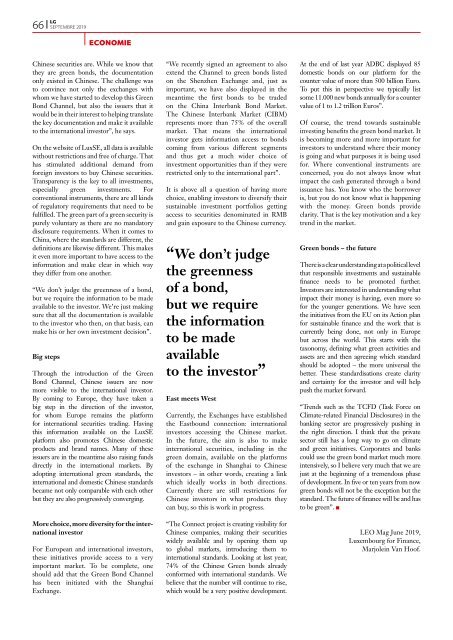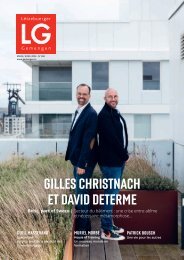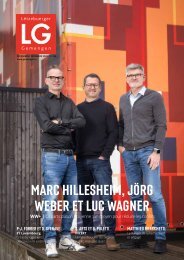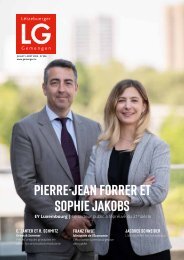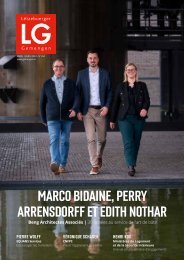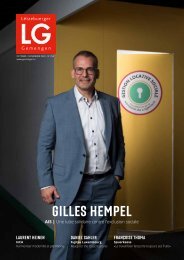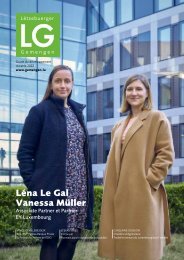LG 226
You also want an ePaper? Increase the reach of your titles
YUMPU automatically turns print PDFs into web optimized ePapers that Google loves.
66 <strong>LG</strong><br />
SEPTEMBRE 2019<br />
ECONOMIE<br />
Chinese securities are. While we know that<br />
they are green bonds, the documentation<br />
only existed in Chinese. The challenge was<br />
to convince not only the exchanges with<br />
whom we have started to develop this Green<br />
Bond Channel, but also the issuers that it<br />
would be in their interest to helping translate<br />
the key documentation and make it available<br />
to the international investor”, he says.<br />
On the website of LuxSE, all data is available<br />
without restrictions and free of charge. That<br />
has stimulated additional demand from<br />
foreign investors to buy Chinese securities.<br />
Transparency is the key to all investments,<br />
especially green investments. For<br />
conventional instruments, there are all kinds<br />
of regulatory requirements that need to be<br />
fulfilled. The green part of a green security is<br />
purely voluntary as there are no mandatory<br />
disclosure requirements. When it comes to<br />
China, where the standards are different, the<br />
definitions are likewise different. This makes<br />
it even more important to have access to the<br />
information and make clear in which way<br />
they differ from one another.<br />
“We don’t judge the greenness of a bond,<br />
but we require the information to be made<br />
available to the investor. We’re just making<br />
sure that all the documentation is available<br />
to the investor who then, on that basis, can<br />
make his or her own investment decision”.<br />
Big steps<br />
Through the introduction of the Green<br />
Bond Channel, Chinese issuers are now<br />
more visible to the international investor.<br />
By coming to Europe, they have taken a<br />
big step in the direction of the investor,<br />
for whom Europe remains the platform<br />
for international securities trading. Having<br />
this information available on the LuxSE<br />
platform also promotes Chinese domestic<br />
products and brand names. Many of these<br />
issuers are in the meantime also raising funds<br />
directly in the international markets. By<br />
adopting international green standards, the<br />
international and domestic Chinese standards<br />
became not only comparable with each other<br />
but they are also progressively converging.<br />
More choice, more diversity for the international<br />
investor<br />
For European and international investors,<br />
these initiatives provide access to a very<br />
important market. To be complete, one<br />
should add that the Green Bond Channel<br />
has been initiated with the Shanghai<br />
Exchange.<br />
“We recently signed an agreement to also<br />
extend the Channel to green bonds listed<br />
on the Shenzhen Exchange and, just as<br />
important, we have also displayed in the<br />
meantime the first bonds to be traded<br />
on the China Interbank Bond Market.<br />
The Chinese Interbank Market (CIBM)<br />
represents more than 75% of the overall<br />
market. That means the international<br />
investor gets information access to bonds<br />
coming from various different segments<br />
and thus get a much wider choice of<br />
investment opportunities than if they were<br />
restricted only to the international part”.<br />
It is above all a question of having more<br />
choice, enabling investors to diversify their<br />
sustainable investment portfolios getting<br />
access to securities denominated in RMB<br />
and gain exposure to the Chinese currency.<br />
“We don’t judge<br />
the greenness<br />
of a bond,<br />
but we require<br />
the information<br />
to be made<br />
available<br />
to the investor”<br />
East meets West<br />
Currently, the Exchanges have established<br />
the Eastbound connection: international<br />
investors accessing the Chinese market.<br />
In the future, the aim is also to make<br />
international securities, including in the<br />
green domain, available on the platforms<br />
of the exchange in Shanghai to Chinese<br />
investors – in other words, creating a link<br />
which ideally works in both directions.<br />
Currently there are still restrictions for<br />
Chinese investors in what products they<br />
can buy, so this is work in progress.<br />
“The Connect project is creating visibility for<br />
Chinese companies, making their securities<br />
widely available and by opening them up<br />
to global markets, introducing them to<br />
international standards. Looking at last year,<br />
74% of the Chinese Green bonds already<br />
conformed with international standards. We<br />
believe that the number will continue to rise,<br />
which would be a very positive development.<br />
At the end of last year ADBC displayed 85<br />
domestic bonds on our platform for the<br />
counter value of more than 500 billion Euro.<br />
To put this in perspective we typically list<br />
some 11.000 new bonds annually for a counter<br />
value of 1 to 1.2 trillion Euros”.<br />
Of course, the trend towards sustainable<br />
investing benefits the green bond market. It<br />
is becoming more and more important for<br />
investors to understand where their money<br />
is going and what purposes it is being used<br />
for. Where conventional instruments are<br />
concerned, you do not always know what<br />
impact the cash generated through a bond<br />
issuance has. You know who the borrower<br />
is, but you do not know what is happening<br />
with the money. Green bonds provide<br />
clarity. That is the key motivation and a key<br />
trend in the market.<br />
Green bonds – the future<br />
There is a clear understanding at a political level<br />
that responsible investments and sustainable<br />
finance needs to be promoted further.<br />
Investors are interested in understanding what<br />
impact their money is having, even more so<br />
for the younger generations. We have seen<br />
the initiatives from the EU on its Action plan<br />
for sustainable finance and the work that is<br />
currently being done, not only in Europe<br />
but across the world. This starts with the<br />
taxonomy, defining what green activities and<br />
assets are and then agreeing which standard<br />
should be adopted – the more universal the<br />
better. These standardisations create clarity<br />
and certainty for the investor and will help<br />
push the market forward.<br />
“Trends such as the TCFD (Task Force on<br />
Climate-related Financial Disclosures) in the<br />
banking sector are progressively pushing in<br />
the right direction. I think that the private<br />
sector still has a long way to go on climate<br />
and green initiatives. Corporates and banks<br />
could use the green bond market much more<br />
intensively, so I believe very much that we are<br />
just at the beginning of a tremendous phase<br />
of development. In five or ten years from now<br />
green bonds will not be the exception but the<br />
standard. The future of finance will be and has<br />
to be green”. n<br />
LEO Mag June 2019,<br />
Luxembourg for Finance,<br />
Marjolein Van Hoof.


